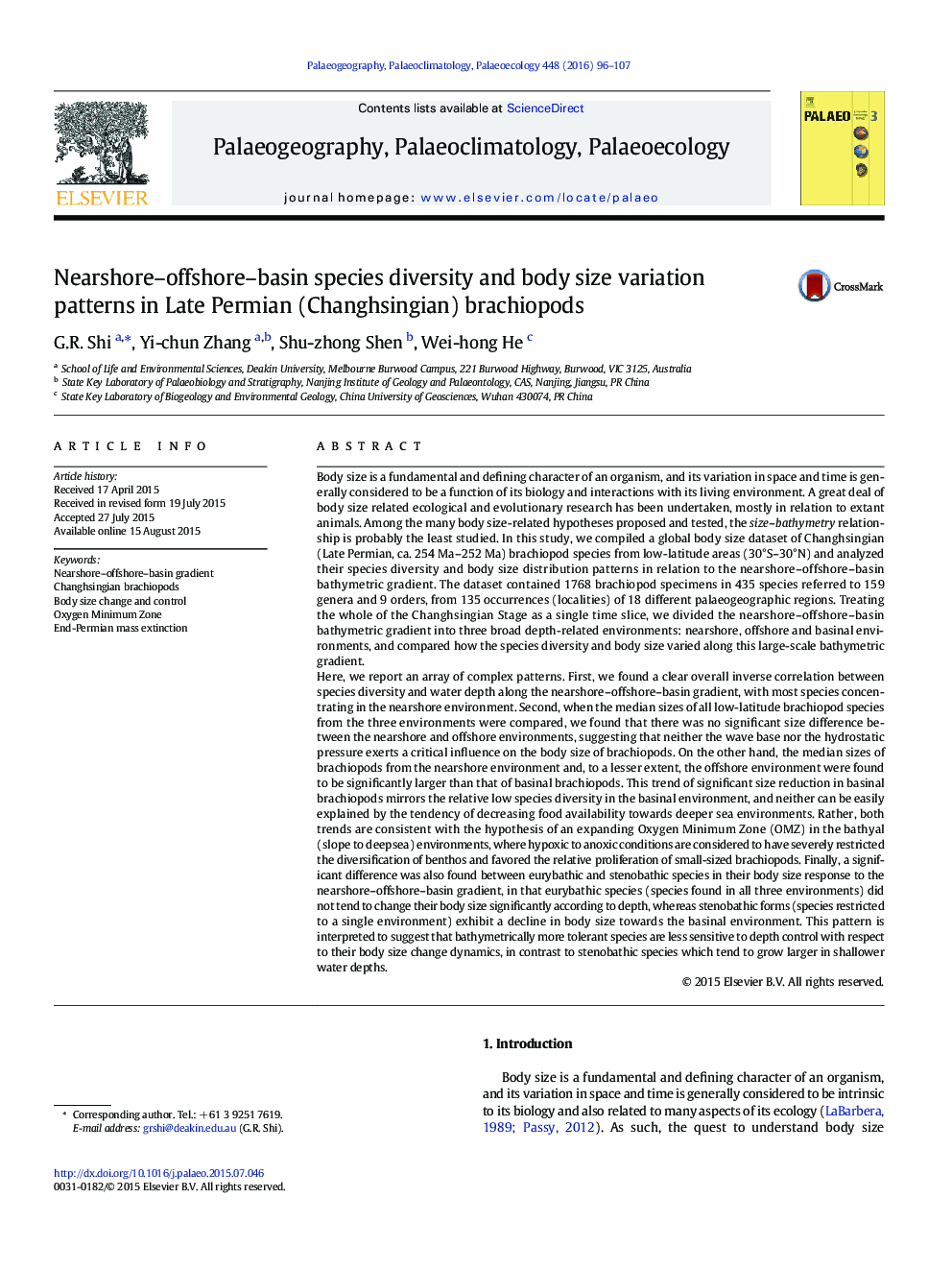| کد مقاله | کد نشریه | سال انتشار | مقاله انگلیسی | نسخه تمام متن |
|---|---|---|---|---|
| 4465842 | 1622143 | 2016 | 12 صفحه PDF | دانلود رایگان |

• Brachiopod species diversity and body size inversely varied with bathymetric gradient.
• OMZ best explains bathymetric gradient of Changhsingian brachiopod species diversity and body size changes.
• Eurybathic species less sensitive to depth in body-size changes compared to stenobathic species
Body size is a fundamental and defining character of an organism, and its variation in space and time is generally considered to be a function of its biology and interactions with its living environment. A great deal of body size related ecological and evolutionary research has been undertaken, mostly in relation to extant animals. Among the many body size-related hypotheses proposed and tested, the size–bathymetry relationship is probably the least studied. In this study, we compiled a global body size dataset of Changhsingian (Late Permian, ca. 254 Ma–252 Ma) brachiopod species from low-latitude areas (30°S–30°N) and analyzed their species diversity and body size distribution patterns in relation to the nearshore–offshore–basin bathymetric gradient. The dataset contained 1768 brachiopod specimens in 435 species referred to 159 genera and 9 orders, from 135 occurrences (localities) of 18 different palaeogeographic regions. Treating the whole of the Changhsingian Stage as a single time slice, we divided the nearshore–offshore–basin bathymetric gradient into three broad depth-related environments: nearshore, offshore and basinal environments, and compared how the species diversity and body size varied along this large-scale bathymetric gradient.Here, we report an array of complex patterns. First, we found a clear overall inverse correlation between species diversity and water depth along the nearshore–offshore–basin gradient, with most species concentrating in the nearshore environment. Second, when the median sizes of all low-latitude brachiopod species from the three environments were compared, we found that there was no significant size difference between the nearshore and offshore environments, suggesting that neither the wave base nor the hydrostatic pressure exerts a critical influence on the body size of brachiopods. On the other hand, the median sizes of brachiopods from the nearshore environment and, to a lesser extent, the offshore environment were found to be significantly larger than that of basinal brachiopods. This trend of significant size reduction in basinal brachiopods mirrors the relative low species diversity in the basinal environment, and neither can be easily explained by the tendency of decreasing food availability towards deeper sea environments. Rather, both trends are consistent with the hypothesis of an expanding Oxygen Minimum Zone (OMZ) in the bathyal (slope to deepsea) environments, where hypoxic to anoxic conditions are considered to have severely restricted the diversification of benthos and favored the relative proliferation of small-sized brachiopods. Finally, a significant difference was also found between eurybathic and stenobathic species in their body size response to the nearshore–offshore–basin gradient, in that eurybathic species (species found in all three environments) did not tend to change their body size significantly according to depth, whereas stenobathic forms (species restricted to a single environment) exhibit a decline in body size towards the basinal environment. This pattern is interpreted to suggest that bathymetrically more tolerant species are less sensitive to depth control with respect to their body size change dynamics, in contrast to stenobathic species which tend to grow larger in shallower water depths.
Journal: Palaeogeography, Palaeoclimatology, Palaeoecology - Volume 448, 15 April 2016, Pages 96–107